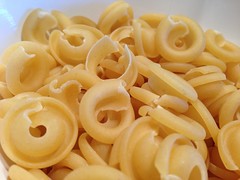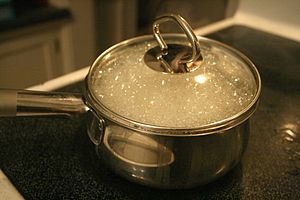Perfectly cooked pasta is easy to achieve and it doesn't require any special or unique gadgets from a high-end cooking store or “as seen on TV” products. All you need is a good sized pot, fresh water, and a big strainer or colander. Chances are you have everything already. Aside from those few items, it all boils down to technique when it comes to cooking perfect pasta. Let's review the basics.
Preparation
| (Photo credit: Guy Renard 25) |
When cooking homemade pasta, be sure that it is fairly dry. The reason it needs to be dry is to keep it from falling apart in the water. It also helps the pasta cook evenly. When you made your pasta you probably added salt, so adding salt to the water is optional for homemade pasta. However, you certainly may add salt if you desire, as well as other seasonings.
Cooking
Choose the largest pot you can for the amount of pasta you're cooking. The reason is you want your pasta to cook in as much water as possible. Pasta needs room to move around. Fill your pot with cold, fresh water and set it on the stove on high heat and bring it to a boil, then turn the heat down a bit until it calms down slightly. Pasta consists of a lot of starch, which gets extremely sticky when it is put into rapidly boiling water quickly. Make sure the water has calmed down from a rapid boil, then slowly and carefully add your pasta. Adding the pasta slowly allows the pasta to soften and begin to move around so the starch doesn't keep the pasta pieces stuck together, as they will if the pasta is added all at once.
Some cooks like to add a little oil to the water to keep the pasta separated. Other cooks don't like to do this because they say sauce doesn't stick to the pasta as well. Just experiment and see what you prefer.
| This pasta is boiling too hard. (Photo credit: Wikipedia) |
When you are cooking the pasta, be sure to stir gently several times and test for doneness often. Follow the instructions on the box if you're using packaged pasta and start testing before the recommended time is up. Just remove a piece from the pot while it's still cooking, cool it off, and bite it. You'll know the pasta's ready when you feel a bit of resistance when you bite down with your teeth. You don't want it to go 'crunch' but you do want a nice feel to it. And remember, it will still cook slightly after you drain it, so less cooked is better.
Draining
Here's where there is some debate. Some cooks swear by rinsing their cooked pasta under hot tap water after it drains in order to remove any starchy residue left. Other cooks say if you cook your pasta correctly there won't be any starchy residue left.
If you added oil to the water, rinsing it will remove most of the oil which defeats the purpose of the oil. Rinsing also will remove all that salt and other flavorings you added. However, if your pasta seems to be sticking together in the colander, you may want to rinse it. And, if you are using your pasta in a cold salad, there are some cooks who recommend running the pasta under cold water to stop it from cooking, keeping it more al dente, and to cool it down for the recipe.
You'll have to experiment on this one. If you follow the first tips about having a lot of water in your pot for the pasta to move around in, salting the water, and keeping the water at a slow roll instead of a rapid boil, your pasta should come out perfectly. Try draining it without rinsing and see what happens. Your pasta could be perfect at that. Or, rinse it if you like and give it a taste and see if that works for you. Perfecting the pasta really takes place in the pot, and not in the strainer or colander.
Cooking pasta perfectly is simple if you know the basics. The fun part after you've mastered this skill is playing around with different flavors and all the varieties of pasta available. Now you'll have perfect pasta, perfectly delicious, every time!
And be sure to check back later this week for some healthy and tasty pasta recipes!



No comments:
Post a Comment
We welcome comments and suggestions!